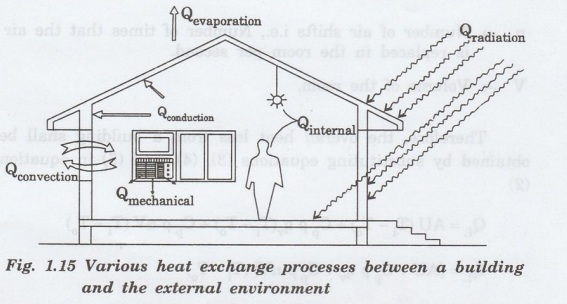Physics For Civil Engineering: Unit I: Thermal Application
Heat Gain and Heat Loss Estimation
Definition, Formula
Heat gain: A heat gain is the rate at which heat enters inside the building or generated within a space at a given instant.
HEAT GAIN AND HEAT LOSS ESTIMATION
Heat gain estimation
Heat
gain: A heat gain is the rate at which heat enters inside
the building or generated within a space at a given instant.
The heat gain in a building is due to
solar radiation through infiltration of heat from equipment and people.
The heat gain by transmission through
any surface is given by the following expression.

where,
Qg -> Heat gain through
transmission by the wall, roof, ceiling, floor or glazing.
A -> Area of the wall, roof, ceiling,
floor or glazing.
U -> Thermal transmittance, air to
air.
Ti -> Inside air
temperature.
To -> Outside air
temperature.
Heat loss estimation
Heat
loss: A heat loss is the rate at which heat flows out
from a building to the surrounding environment.
Heat losses is due to heat conduction
through the envelop and due to the exchange of warm and cold air through
ventilation and infiltration.
The overall heat loss from a building is
calculted as
QL = Qt + Qv
+ Qi..............................(2)
where,
Qt -> Heat loss due to transmission
through walls, windows, doors, floors, etc.
Qv -> Heat loss caused by
ventilation.
Qi -> Heat loss caused by infiltration.
Heat loss by Transmission
The heat loss through walls, s, windows,
doors, ceilings, floors, etc. is calculated as
Qt =AU [Ti - To]............................(3)
where,
Qt -> Tranmission heat loss.
A
-> Area of exposed surface.lg
U -> Overall heat transmission
coefficient.
To -> Outside air
temperature
Heat loss by ventilation
The heat loss due to ventilation without
heat recovery is expressed as
Qv = Cp P qv
[Ti - To]................................(4)
where,
Qv -> Ventilation heat loss egradoxe
Cp → Specific heat capacity
of air
P -> Density of air
qv -> Volume of air flow
Heat loss by infiltration
The heat lose caused by infiltration is
calculated as

Where,
n → Number of air shifts i.e., Number of
times that the air is replaced in the room per second.
V→ Volume of the room.
Therefore, the overall heat loss from a
building shall be obtained by substituting equations (3), (4), and (5) in
equation (2)

Thermal Performance of Buildings
Definition
It refers to the process of modelling the
energy transfer between a building and its surroundings.
• For
a conditioned building, it estimates the heating and cooling load. Hence, the
capacity and selection of Heating, Ventilation and Air conditioning (HVAC)
equipment can be correctly made.
• For
a non-conditioned building, it calculates temperature variation inside the
building over a specified time. It helps us to estimate the duration of
uncomfortable periods.
• These
quantifications enable us to determine the effectiveness of the design of a
building. They help in evolving improved designs for realizing energy efficient
buildings with comfortable indoor conditions.
• The
various heat exchange processes between a building and the external environment
are shown in fig. 1.15.

Heat
Exchange processes between a building and the external environment
• Heat
flows by conduction through various building elements such as walls, roof,
ceiling, floor, etc. Heat transfer also takes place from different surfaces by
convection and radiation.
• Besides,
solar radiation is transmitted through transparent windows and it is absorbed
by the internal ao surfaces of the building.
• There
may be evaporation of water resulting in a cooling effect. Heat is also added
to the space due to the presence of human occupants and the use of lights and
equipments.
The interaction between a human body and
the indoor environment is shown in fig. 1.16.

Physics For Civil Engineering: Unit I: Thermal Application : Tag: : Definition, Formula - Heat Gain and Heat Loss Estimation
Related Topics
Related Subjects
Physics for Civil Engineering
PH3201 2021 Regulation | 2nd Semester Civil Dept 2021 Regulation
